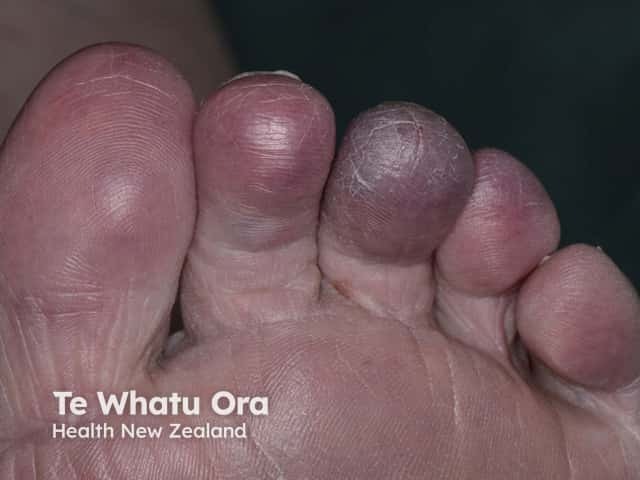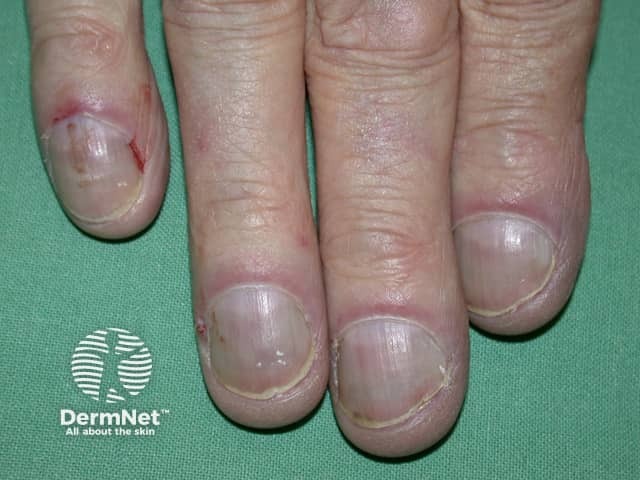Main menu
Common skin conditions

NEWS
Join DermNet PRO
Read more
Quick links
Acrocyanosis — extra information
Acrocyanosis
Author: Gemma Law, Final Year Medical Student at Monash University; Chief Editor: Dr Amanda Oakley, Dermatologist, Hamilton, New Zealand, October 2015.
Introduction Demographics Causes Clinical features Diagnosis Treatment Outcome
What is acrocyanosis?
Acrocyanosis is a functional peripheral vascular disorder characterised by dusky mottled discolouration, or cyanosis, of the hands, feet, and sometimes the face.
Acrocyanosis is caused by vasospasm of the small vessels of the skin in response to cold. It can be primary or secondary.
Who gets acrocyanosis?
Primary acrocyanosis most often presents in adolescents and young adults (onset is often in the 20s–30s).
- It is more common in females than in males.
- Acrocyanosis is rarely seen in children or post-menopausal women.
- It may coexist with chilblains, erythromelalgia, or Raynaud phenomenon.
Secondary acrocyanosis can present at any age, depending on the underlying cause.
What causes acrocyanosis?
Causes of acrocyanosis depend on whether it is primary or secondary.
Primary acrocyanosis
Primary acrocyanosis is genetically determined or of unknown origin. It is not associated with occlusive arterial disease. Chronic vasospasm of small cutaneous arterioles or venules results in secondary dilatation of capillaries and the sub-papillary venous plexus.
Secondary acrocyanosis
Contributing factors leading to secondary acrocyanosis can include:
- Hypoxaemia, often due to lung disease or smoking
- Connective tissue diseases (eg, granulomatosis with polyangiitis, rheumatoid arthritis, lupus erythematosus, overlap syndrome)
- Neoplasms (eg, Hodgkin lymphoma, ovarian cancer)
- Occlusive arterial diseases (peripheral vascular disease)
- Eating disorders and malnutrition
- Haematological disorders
- Drugs and toxins
- Infections
- Atopic dermatitis
- Heritable diseases (eg, mitochondrial disease, Down syndrome, Ehlers-Danlos syndrome)
- Infancy
- Buerger disease
- Spinal cord injury
- Atrophic rhinitis
- Psychiatric/psychological reasons.
What are the clinical features of acrocyanosis?
Primary acrocyanosis
Primary acrocyanosis presents with bilateral, symmetrical, painless and persistent blue discolouration of fingers and toes. Acrocyanosis may extend to include hands, feet and face. Pressure on an area of blanching leads to a slow and irregular return of blood from the periphery towards the centre (Crocq sign). Arterial pulses are normal, and there is no proximal pallor, ulceration or gangrene.
Clinical features of acrocyanosis may also include:
- Hyperhidrosis of hands and feet
- Cold hands and feet
- Swelling of digits
Secondary acrocyanosis
The presentation of secondary acrocyanosis varies depending on the underlying cause. Secondary acrocyanosis is often asymmetrical and is associated with pain and tissue damage (blue toe syndrome).
Signs of a primary disorder may be present.

Secondary acrocyanosis

Secondary acrocyanosis

Secondary acrocyanosis
How is acrocyanosis diagnosed?
Clinical diagnosis of acrocyanosis is based on the patient's general appearance and the distribution and persistence of cyanosis.
In young adults, where the diagnosis is most likely to be primary acrocyanosis, only limited investigations are required.
In older adults, or if there are atypical features such as pain and asymmetry of acrocyanosis, a targeted history, examination and investigations will be required to determine the cause. Investigations may include:
- Pulse oximetry
- Urinalysis
- Full blood count, C-reactive protein, ESR
- Standard biochemistry including liver and kidney function
- Streptococcal titres
- Autoantibodies
- Immunoglobulins and plasma electrophoresis
- Complement studies
- Chest X-ray
- Arterial and venous blood gas measurements
- Skin biopsy
- Nailfold capillaroscopy (to distinguish primary cyanosis from early stage connective tissue disorders).
What is the treatment for acrocyanosis?
Primary acrocyanosis
Treatment is not required for the majority of patients with acrocyanosis and pharmacological intervention is rarely necessary. The patient should be reassured that the condition is harmless. Options for active management may include:
- Behavioural measures, such as avoidance of cold exposure and trauma
- Psychophysiological measures, such as biofeedback training, reflex conditioning and hypnosis.
Note that vasodilators, eg calcium channel blockers, are not helpful (unlike in Raynaud phenomenon).
- There is limited evidence for benefit from bioflavonoids, nicotinic acid derivatives, adrenergic blockers, topical minoxidil, cyclandelate, rutin compounds, and bromocriptine.
- Sympathectomy may be considered in very severe cases.
Secondary acrocyanosis
Treatment of secondary acrocyanosis depends on the underlying cause.
What is the outcome for acrocyanosis?
Primary acrocyanosis is a benign condition that usually resolves in middle age with no long-term sequelae.
Secondary acrocyanosis may resolve with treatment of primary cause. As the pathological mechanisms that cause secondary acrocyanosis vary, so does prognosis.
References
- Dyer JA. Chapter 94: Cold Injuries. In: Fitzpatrick’s Dermatology in General Medicine. 8th ed. McGraw-Hill Education; 2012.
- Kurklinsky AK, Miller VM, Rooke TW. Acrocyanosis: The Flying Dutchman. Vasc Med. 2011 Aug 1;16(4):288–301. PubMed
- Patrick J Brown MJZ. The purple digit: An algorithmic approach to diagnosis. Am J Clin Dermatol. 2010;11(2):103–16. PubMed
- Heidrich. Functional vascular diseases: Raynaud's syndrome, acrocyanosis and erythromelalgia. Vasa. 2010 Feb 1;39(1):33–41. PubMed
- Chadachan V, Eberhardt RT. Chapter 49: Acrocyanosis. In: Loscalzo MACAB, editor. Vascular Medicine: A Companion to Braunwald’s Heart Disease (Second Edition). Philadelphia: W.B. Saunders; 2013.
On DermNet
Other websites
- Acrocyanosis — Merck Manual Professional Version
- Functional Peripheral Arterial Disease — Merck Manual Consumer Version
- Das S, Maiti1 A. Acrocyanosis: An Overview. Indian J Dermatol. 2013 Nov-Dec; 58(6): 417–20. doi: 10.4103/0019-5154.119946. PubMed
